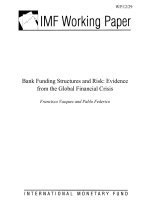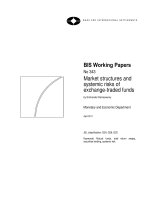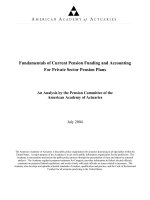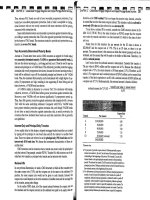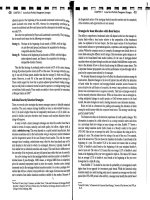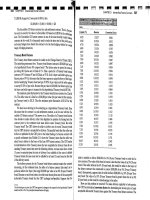Collateralized debt obligations structures and analysis by laurie s goodman and frank j fabozzi
Bạn đang xem bản rút gọn của tài liệu. Xem và tải ngay bản đầy đủ của tài liệu tại đây (3.82 MB, 386 trang )
Collateralized Debt Obligations:
structures and
analysis
LAURIE S. GOODMAN
FRANK J. FABOZZI
John Wiley & Sons, Inc.
frontmatter Page viii Monday, August 12, 2002 11:55 AM
frontmatter Page i Monday, August 12, 2002 11:55 AM
Collateralized Debt Obligations:
structures and
analysis
frontmatter Page ii Monday, August 12, 2002 11:55 AM
THE FRANK J. FABOZZI SERIES
Fixed Income Securities, Second Edition by Frank J. Fabozzi
Focus on Value: A Corporate and Investor Guide to Wealth Creation by James L.
Grant and James A. Abate
Handbook of Global Fixed Income Calculations by Dragomir Krgin
Managing a Corporate Bond Portfolio by Leland E. Crabbe and Frank J. Fabozzi
Real Options and Option-Embedded Securities by William T. Moore
Capital Budgeting: Theory and Practice by Pamela P. Peterson and Frank J. Fabozzi
The Exchange-Traded Funds Manual by Gary L. Gastineau
Professional Perspectives on Fixed Income Portfolio Management, Volume 3 edited
by Frank J. Fabozzi
Investing in Emerging Fixed Income Markets edited by Frank J. Fabozzi and
Efstathia Pilarinu
Handbook of Alternative Assets by Mark J. P. Anson
The Exchange-Traded Funds Manual by Gary L. Gastineau
The Handbook of Financial Instruments edited by Frank J. Fabozzi
The Global Money Markets by Frank J. Fabozzi, Steven V. Mann, and
Moorad Choudhry
The Theory and Practice of Investment Management edited by Frank J. Fabozzi and
Harry M. Markowitz
frontmatter Page iii Monday, August 12, 2002 11:55 AM
Collateralized Debt Obligations:
structures and
analysis
LAURIE S. GOODMAN
FRANK J. FABOZZI
John Wiley & Sons, Inc.
frontmatter Page iv Monday, August 12, 2002 11:55 AM
LSG
To my husband Mark
and my children Louis, Arthur, Benjamin, and Pamela
FJF
To my wife Donna
and my children, Karly, Patricia, and Francesco
Copyright © 2002 by Frank J. Fabozzi and Laurie S. Goodman. All rights reserved.
Published by John Wiley & Sons, Inc., Hoboken, New Jersey
Published simultaneously in Canada
No part of this publication may be reproduced, stored in a retrieval system, or transmitted in
any form or by any means, electronic, mechanical, photocopying, recording, scanning, or otherwise, except as permitted under Section 107 or 108 of the 1976 United States Copyright
Act, without either the prior written permission of the Publisher, or authorization through
payment of the appropriate per-copy fee to the Copyright Clearance Center, Inc., 222 Rosewood Drive, Danvers, MA 01923, 978-750-8400, fax 978-750-4470, or on the web at
www.copyright.com. Requests to the Publisher for permission should be addressed to the Permissions Department, John Wiley & Sons, Inc., 111 River Street, Hoboken, NJ 07030, 201748-6011, fax 201-748-6008, e-mail:
Limit of Liability/Disclaimer of Warranty: While the publisher and authors have used their
best efforts in preparing this book, they make no representations or warranties with respect to
the accuracy or completeness of the contents of this book and specifically disclaim any implied
warranties of merchantability or fitness for a particular purpose. No warranty may be created
or extended by sales representatives or written sales materials. The advice and strategies contained herein may not be suitable for your situation. You should consult with a professional
where appropriate. Neither the publisher nor authors shall be liable for any loss of profit or
any other commercial damages, including but not limited to special, incidental, consequential,
or other damages.
For general information on our other products and services, or technical support, please contact our Customer Care Department within the United States at 800-762-2974, outside the
United States at 317-572-3993 or fax 317-572-4002.
Wiley also publishes its books in a variety of electronic formats. Some content that appears in
print may not be available in electronic books.
ISBN: 0-471-23486-9
Printed in the United States of America
10 9 8 7 6 5 4 3 2 1
frontmatter Page v Monday, August 12, 2002 11:55 AM
contents
Preface
vii
About the Authors
ix
CHAPTER 1
Introduction
1
CHAPTER 2
Cash Flow CDOs
15
CHAPTER 3
High-Yield Default Rates and Their Application to CDO Analysis
41
CHAPTER 4
Review of Structured Finance Collateral
71
CHAPTER 5
Structured Finance Cash Flow CDOs
129
CHAPTER 6
Emerging Market CDOs
159
CHAPTER 7
Market Value CDOs
173
CHAPTER 8
Synthetic Balance Sheet CDOs
193
CHAPTER 9
Synthetic Arbitrage CDOs
217
v
frontmatter Page vi Monday, August 12, 2002 11:55 AM
vi
Contents
CHAPTER 10
Considerations in Creating CDOs and Their Investment Implications
235
CHAPTER 11
Participating Coupon Notes
257
CHAPTER 12
Relative Value Methodology for Analyzing Mezzanine Tranches
271
CHAPTER 13
Analyzing CDO Equity Tranches
287
CHAPTER 14
Payment-in-Kind CDO Tranches
317
CHAPTER 15
Secondary Market Trading Opportunities and Managing a Portfolio of CDOs
331
INDEX
361
frontmatter Page vii Monday, August 12, 2002 11:55 AM
preface
he market for collateralized debt obligations (CDOs) is the fastest growing sector of the asset-backed securities market. In 2000 and 2001,
CDOs constituted over 25% of total ABS issuance, up from under 1% of
the market six years earlier. Looked at differently, in 1995, one major bond
rating agency rated only six deals, representing a combined par value of $1
billion. By 2001, that same rating agency rated 277 deals totaling $101 billion par value.
There have been numerous and dramatic changes within the CDO
market as it evolved. For instance, bank balance sheet deals are now less
important, arbitrage deals more significant, while synthetic deals have
grown more rapidly than alternative structures. Collateral mix has also
shifted dramatically, with high-yield bond collateral now less prevalent
and structured finance collateral more common.
Our purpose in writing this book was to provide financial market
participants with a basic, but comprehensive, understanding of the CDO
market as it currently stands. And since this is an evolving market with
new variations constantly appearing, we also provide a framework for
examining new structures.
We gratefully acknowledge the expertise and participation of the UBS
Warburg Securitized Products Strategy Team; Jeff Ho, Tom Zimmerman,
Douglas Lucas, and Vicki Ye all made terrific contributions to this book.
Jeff coauthored Chapter 12. Tom had a major impact on Chapters 4 and
5. Douglas coauthored Chapter 14 plus made significant contributions to
Chapters 5 and 13. Vicki was involved at every step, from background
research and data gathering to reading/critiquing the final product. In
addition, we are grateful to Glenn Boyd, Laurent Gauthier, and Wilfred
Wong, also of UBS Warburg’s Securitized Products Strategy Team, who
reviewed many a draft and made helpful comments.
We particularly thank the bond rating agencies Moody’s Investors
Service, Standard & Poor’s, and Fitch, for allowing us to draw on the
wealth of data and expertise they have provided to investors over time.
Most specifically, we incorporated material on their rating methodologies, and default and rating transition studies.
T
Laurie S. Goodman
Frank J. Fabozzi
vii
frontmatter Page viii Monday, August 12, 2002 11:55 AM
frontmatter Page ix Monday, August 12, 2002 11:55 AM
about the authors
Laurie S. Goodman is a Managing Director at UBS Warburg and head of
the U.S. Securitized Products Strategy Group. The team is responsible for
the Mortgage Strategist and CDO Insight publications and for relative
value trade recommendations across the U.S. securitized marketplace—
RMBS, ABS, CMBS, and CDOs. In 2001, Ms. Goodman was elected to the
Institutional Investor All-American Fixed Income Research Team for the
ninth year. For the past four years, she has held the #1 slots for MBS Strategy, Agency Structured Product, and Non-Agency Structured Product. She
is also Institutional Investor ranked for CDO Research. Prior to joining
UBS Warburg in 1993, Ms. Goodman held similar research positions at
Merrill Lynch, Goldman Sachs, and Citibank. She also had buy-side experience and spent four years as a senior economist at the Federal Reserve Bank
of New York. She has published more than 150 articles in academic and
professional journals, most on portfolio management and the valuation of
fixed income securities. Ms. Goodman holds a B.A. in Mathematics from
the University of Pennsylvania, and M.A. and Ph.D. degrees in Economics
from Stanford University.
Frank J. Fabozzi is editor of the Journal of Portfolio Management and an
Adjunct Professor of Finance at Yale University’s School of Management
where he teaches the structured finance course. From 1986 to 1992, he
was a full-time professor of finance at MIT’s Sloan School of Management. He is on the board of directors of the BlackRock complex of funds,
the board of directors of the Guardian Life family of funds, and an advisory analyst for Global Asset Management (GAM). Dr. Fabozzi has
edited and authored many acclaimed books in finance, including three
coauthored with Franco Modigliani, recipient of the 1985 Alfred Nobel
Memorial Prize in Economic Sciences, and an edited book with Harry M.
Markowitz, corecipient of the 1990 Nobel Memorial Prize in Economic
Sciences. He earned a doctorate in economics from the City University of
New York in 1972 and is a Fellow of the International Center for Finance
at Yale University. Dr. Fabozzi is a Chartered Financial Analyst and Certified Public Accountant.
ix
frontmatter Page x Monday, August 12, 2002 11:55 AM
CHAPTER
1
Introduction
collateralized debt obligation (CDO) is an asset-backed
security backed by a diversified pool of one or more
classes of debt (corporate and emerging market bonds, assetbacked and mortgage-backed securities, real estate investment trusts, and bank debt). The list of asset types included
in a CDO portfolio is continually expanding. When the
underlying pool of debt obligations consists of bond-type
instruments, the CDO is referred to as a collateralized bond
obligation (CBO). When the underlying pool of debt obligations consists of only bank loans, the CDO is referred to as a
collateralized loan obligation (CLO).
A
STRUCTURE OF A CDO
In a CDO structure, there is an asset manager responsible for
managing the portfolio of debt obligations. There are restrictions imposed (i.e., restrictive covenants) as to what the asset
manager may do and certain tests that must be satisfied for
the debt obligations in the CDO to maintain the credit rating
assigned at the time of issuance. We’ll discuss these requirements in later chapters.
The funds to purchase the underlying assets, referred to
as the collateral assets, are obtained from the issuance of
1
2
COLLATERALIZED DEBT OBLIGATIONS: STRUCTURES AND ANALYSIS
debt obligations. These debt obligations are also referred to
as tranches. The tranches are:
■
■
■
Senior tranches
Mezzanine tranches
Subordinate/equity tranche
There will be a rating sought for all but the subordinate/
equity tranche. For the senior tranches, at least an A rating
is typically sought. For the mezzanine tranches, a rating of
BBB but no less than B is sought. Since the subordinate/
equity tranche receives the residual cash flow, no rating is
sought for this tranche.
The order of priority of the payments of interest and principal to the CDO tranches is specified in the prospectus. We
will describe how the cash flow payments are distributed in
later chapters. What is important to understand is that the
payments are made in such a way as to provide the highest
level of protection to the senior tranches in the structure. This
is done by providing certain tests that must be satisfied before
any distribution of interest and principal may be distributed
to the other tranches in the structure. If certain tests are failed,
the senior tranches are then retired until the tests are passed.
The ability of the asset manager to make the interest
payments to the debt holders and repay principal to the
debt holders depends on the performance of the collateral
assets. The proceeds to meet the obligations to the CDO
tranches (interest and principal repayment) can come from
■
■
■
Coupon interest payments from the collateral assets
Maturity of collateral assets
Sale of collateral assets
There are three relevant periods in the life of a CDO.
The first is the ramp-up period. This is the period that follows the closing date of the transaction when the asset man-
Introduction
3
ager begins investing the proceeds from the sale of the debt
obligations issued. This period usually lasts less than one
year. The reinvestment period or revolving period is when
principal proceeds received from the collateral assets are
reinvested; this period is usually five or more years. In the
final period, the collateral assets are sold and the debt holders are paid off.
A deal can be terminated early if certain events of
default occur. These events basically relate to conditions
that would materially and adversely impact the performance
of the collateral assets. Such events include (1) the failure to
comply with certain covenants; (2) failure to meet payments
(interest and/or principal) to the senior tranches; (3) bankruptcy of the issuing entity of the CDO; and (4) departure
of the asset management team if an acceptable replacement
is not found.
SPONSOR MOTIVATION
CDOs are categorized based on the motivation of the sponsor
of the transaction. If the motivation of the sponsor is to earn
the spread between the yield offered on the collateral assets
and the payments made to the various tranches in the structure, then the transaction is referred to as an arbitrage transaction. If the motivation of the sponsor is to remove debt
instruments (primarily loans) from its balance sheet, then the
transaction is referred to as a balance sheet transaction.
Sponsors of balance sheet transactions are typically financial
institutions such as banks and insurance companies seeking
to reduce their capital requirements by removing loans due to
their higher risk-based requirements.
Economics of an Arbitrage Transaction
The key as to whether or not it is economic to create an arbitrage CDO is whether or not a structure can offer a competitive return for the subordinate/equity tranche.
4
COLLATERALIZED DEBT OBLIGATIONS: STRUCTURES AND ANALYSIS
To understand how the subordinate/equity tranche generates cash flows, consider the following basic $100 million
CDO structure with the coupon rate to be offered at the
time of issuance as shown:
Tranche
Par Value
Coupon Rate
Senior
Mezzanine
Subordinated/equity
$80,000,000
10,000,000
10,000,000
LIBOR + 70 basis points
Treasury rate plus 200 basis points
—
Suppose that the collateral assets consist of bonds that all
mature in 10 years and the coupon rate for every bond is the
10-year Treasury rate plus 400 basis points. Notice that the
collateral assets pay a fixed rate but 80% of the capital
structure is based on a floating rate (LIBOR). Thus, there is a
mismatch with respect to the coupon characteristics of the
collateral assets and the liabilities. One way that the asset
manager hedges this mismatch is by using an interest rate
swap. A swap is simply an agreement to periodically
exchange interest payments with the payments benchmarked
off of a notional amount. The notional amount is not
exchanged between the two swap parties. Rather it is used
simply to determine the dollar interest payment of each
party. This is all we need to know about an interest rate
swap in order to understand the economics of an arbitrage
transaction. Keep in mind, the goal is to show how the subordinate/equity tranche can be expected to generate a return.
The interest rate swap that the asset manager would use
would have a notional amount of $80 million. Suppose that
the terms of the interest rate swap are as follows:
■
■
The asset manager must pay a fixed rate each year equal to
the 10-year Treasury rate plus 100 basis points
The asset manager receives LIBOR
Introduction
5
Let’s assume that the 10-year Treasury rate at the time
the CDO is issued is 7%. Now we can walk through the
cash flows for each year. Look first at the collateral assets.
The collateral assets will pay interest each year (assuming
no defaults) equal to the 10-year Treasury rate of 7% plus
400 basis points. So the interest will be:
Interest from collateral assets = 11% × $100,000,000 = $11,000,000
Now let’s determine the interest that must be paid to the
senior and mezzanine tranches. For the senior tranche, the
interest payment will be:
Interest to senior tranche = $80,000,000 × (LIBOR + 70 bp)
The coupon rate for the mezzanine tranche is 7% plus 200
basis points. So, the coupon rate is 9% and the interest is:
Interest to mezzanine tranche = 9% × $10,000,000 = $900,000
Finally, let’s look at the interest rate swap. The asset
manager is agreeing to pay the swap counterparty each year
7% (the 10-year Treasury rate) plus 100 basis points, or 8%
of the notional amount. In our illustration, the notional
amount is $80 million. The reason the asset manager
selected the $80 million is because this is the amount of
principal for the senior tranche. So, the asset manager pays
to the swap counterparty:
Interest to swap counterparty = 8% × $80,000,000 = $6,400,000
The interest payment received from the swap counterparty is LIBOR based on a notional amount of $80 million.
That is,
Interest from swap counterparty = $80,000,000 × LIBOR
6
COLLATERALIZED DEBT OBLIGATIONS: STRUCTURES AND ANALYSIS
Now we can put this all together. Let’s look at the interest coming into the CDO:
Interest from collateral assets
Interest from swap counterparty
Total interest received
$11,000,000
$80,000,000 × LIBOR
$11,000,000 + $80,000,000 × LIBOR
The interest to be paid out to the senior and mezzanine
tranches and to the swap counterparty include:
Interest to senior tranche
Interest to mezzanine tranche
Interest to swap counterparty
Total interest paid
$80,000,000 × (LIBOR + 70 bp)
$900,000
$6,400,000
$7,300,000 + $80,000,000 × (LIBOR + 70 bp)
Netting the interest payments coming in and going out
we have:
Total interest received
− Total interest paid
Net interest
$11,000,000 + $80,000,000 × LIBOR
$7,300,000 + $80,000,000 × (LIBOR + 70 bp)
$3,700,000 − $80,000,000 × (70 bp)
Since 70 basis points times $80 million is $560,000, the net
interest remaining is $3,140,000 (= $3,700,000 − $560,000).
From this amount any fees (including the asset management
fee) must be paid. The balance is then the amount available
to pay the subordinate/equity tranche. Suppose that these
fees are $634,000. Then the cash flow available to the subordinate/equity tranche is $2.5 million. Since the tranche
has a par value of $10 million and is assumed to be sold at
par, this means that the return is 25%.
Obviously, some simplifying assumptions have been
made. For example, it is assumed that there are no defaults
for the collateral assets. It is assumed that all of the collateral
assets purchased by the asset manager are noncallable and
therefore the coupon rate would not decline because issues
are called. Moreover, as explained earlier, at the end of the
reinvestment period the asset manager must begin repaying
Introduction
7
principal to the senior and mezzanine tranches. Consequently, the interest swap must be structured to take this into
account since the entire amount of the senior tranche is not
outstanding for the life of the collateral assets. Despite the
simplifying assumptions, the illustration does demonstrate
the basic economics of the CDO, the need for the use derivative instruments—in the example, an interest rate swap—and
how the subordinate/equity tranche will realize a return.
Types of Arbitrage Transactions:
Cash Flow versus Market Value
Arbitrage transactions can be divided into two types depending on what the primary source of the proceeds from the collateral assets are to satisfy the CDO debt obligations. If the
primary source is the interest and maturing principal from the
collateral assets, then the transaction is referred to as a cash
flow transaction. If instead the proceeds to meet the CDO
debt obligations depends heavily on the total return generated
from the active management of the collateral assets, then the
transaction is referred to as a market value transaction.
SYNTHETIC CDO TRANSACTIONS
A synthetic CDO is so named because the CDO does not
actually own the pool of assets on which it has the risk.
Stated differently, a synthetic CDO absorbs the economic
risks, but not the legal ownership, of its reference credit
exposures. The nonsynthetic CDO is referred to as a “cash”
structure. Synthetic CDO structures are now widely used in
both arbitrage and balance sheet transactions.
The building block for synthetic CDOs is a credit derivative. More specifically, it a credit default swap, which allows
the transfer of the economic risk of a pool of asset, but not
the legal ownership, of underlying assets. The dominant
synthetic CDOs has historically been synthetic balance sheet
CDOs. As explained in Chapter 8, where we discuss syn-
8
COLLATERALIZED DEBT OBLIGATIONS: STRUCTURES AND ANALYSIS
thetic CDOs, the motivation of the sponsor is to obtain
relief from risk-based capital requirements.
The fastest growing type of synthetic CDO is the synthetic arbitrage CDO, the subject of Chapter 9. As explained
in that chapter, we expect that synthetic arbitrage CDOs will
continue to grow because of the advantages of a synthetic
structure relative to its cash structure counterparty.
USE OF DERIVATIVES IN CDO TRANSACTIONS
From our discussion of the structure of CDOs and the types
of CDOs, we can see why it is common to have embedded
within a CDO transaction a derivative instrument. Obligations to the counterparty of a derivative instrument embedded in a CDO have priority over payments to any of the
CDO debt obligations.
In general, derivative instruments can be classified as
futures/forwards, options, swaps, and caps/floors. Derivatives can be further categorized based on the type of risk that
they can protect against: interest rate risk or credit risk.
Interest Rate Derivatives
An interest rate derivative can be used to protect against
adverse movements in the general level of interest rates. We
illustrated earlier in this chapter in explaining the economics
of an arbitrage transaction one type of interest rate derivative, an interest rate swap. Exhibit 1.1 shows a flow chart of
an interest rate swap where the reference rate for the floatingrate side is LIBOR. The interest rate swap can be used to provide a matching of the cash flow characteristics of the assets
and liabilities. In this example, an interest rate swap was used
to convert fixed-rate coupon payments from the collateral
assets into a floating-rate payments in order to match the
floating interest payments to the senior tranche.
9
Introduction
EXHIBIT 1.1
Interest Rate
Swap
Counterparty
Bond-Backed CDO and Interest Rate Swap
LIBOR-Based
Coupons
LIBOR-Based
Coupons
CDO
Fixed-rate
Coupons
Debt Tranche
Holders
Fixed-Rate
Coupons
Collateral
Assets
A more efficient way to hedge a bond-backed CDO transaction depending on market conditions may be to purchase
an interest rate cap rather than entering into an interest rate
swap. An interest cap is an agreement between two parties
whereby one party, for an upfront premium, agrees to compensate the other if the reference rate is above a predetermined level (referred to as the “strike rate”). This protects
the CDO transaction from an increase in its interest payments to the floating-rate tranches should interest rates rise.
The party that benefits, if the reference rate exceeds the reference rate, is called the cap buyer and the party that must
make the payment is called the cap seller. The terms of an
interest rate cap include (1) the reference rate; (2) the strike
rate that sets the cap; (3) the length of the agreement; (4) the
frequency of reset; and, (5) the notional amount. The payoff
for the cap buyer at a reset date, if the value of the reference
rate exceeds the cap rate on that date, is the greater of zero
and the difference between the cap rate and the strike rate
multiplied by the notional amount (adjusted for the frequency of the payment). Exhibit 1.2 shows the flow chart for
a bond-backed CDO deal with an interest rate cap.
10
EXHIBIT 1.2
Interest Rate
Cap
Counterparty
COLLATERALIZED DEBT OBLIGATIONS: STRUCTURES AND ANALYSIS
Bond-Backed CDO and Interest Rate Cap
Maximum of
Zero &
LIBOR minus
Fixed-Rate
CDO
LIBOR-Based
Coupons
Debt Tranche
Holders
Fixed-Rate
Coupons
Collateral
Assets
Credit Derivatives
Interest rate derivatives such as interest rate swaps and caps
can be used to control the interest rate risk in a CDO transaction with respect to changes in the level of interest rates.
Derivative instruments designed to provide protection against
credit risk are called credit derivatives.
Credit risk can be divided into three types: default risk,
credit spread risk, and downgrade risk. Default risk is defined
as the risk that the issuer will fail to satisfy the terms of the
obligation with respect to the timely payment of interest and
repayment of the amount borrowed. Credit spread risk is the
risk that an issuer’s debt obligation will decline in value due
to an increase in the credit spread. Downgrade risk is the risk
that issue will be downgraded by a rating agency.
As explained earlier, credit derivatives are used in synthetic CDO transactions. While there are various types of
credit derivatives—credit options, credit forwards, and
credit default swaps—the one used in a synthetic CDO
transaction is a credit default swap. This is used to protect
against default risk. Since the term of a CDO is usually a
minimum of five years, and the debt holder receives his or
her money back at maturity, assuming defaults are limited,
it is unnecessary to protect against credit spread risk and
downgrade risk.
Introduction
11
OVERVIEW OF BOOK
In Chapter 2 we discuss cash flow transactions—the distribution of the cash flows, restrictions imposed on the asset manager to protect the debt holders, and the key factors
considered by rating agencies in rating tranches. Our focus in
the chapter is on deals backed by high-yield corporate bonds.
In Chapter 3 we describe how the rating agencies view
defaults and how they use them in developing the weighted
average rating factors for CDOs. Because of the transparency of the rating methodology to investors, we then
explain why relative value opportunities arise in the CDO
market due to the way defaults and potential defaults are
viewed by investors and how the opportunities can be identified by investors using credit analysis.
In Chapters 4 and 5 we discuss CDOs backed by structured finance products—residential mortgage-backed securities, commercial mortgage-backed securities, asset-backed
securities, and real estate investment trusts. In Chapter 4 we
review structured finance products. In Chapter 5 we then
look at structured finance cash flow CDOs beginning with
the similarities of and differences between structured
finance cash flow CDO structures and high-yield corporate
bond CDO structures. We then review the relative credit
quality of structured finance debt versus corporate debt as
CDO collateral, concluding that by using the same criteria
to rate all types of CDOs, the rating agencies impose an
extra burden on those backed by structured finance collateral. As a result, the ratings are conservative and thereby
offer investors relative value opportunities.
In Chapter 6 we look at CDOs backed by sovereign
emerging market bonds, focusing on the differences (that
matter) between emerging markets and high-yield deals. We
conclude that the rating agencies are far more conservative
in their assumptions when rating emerging market deals
than in rating high-yield deals. Again, this leads to relative
value opportunities.
1-Intro to CDOs Page 12 Monday, August 12, 2002 9:19 AM
12
COLLATERALIZED DEBT OBLIGATIONS: STRUCTURES AND ANALYSIS
Market value CDOs are the subject of Chapter 7. While
the number of market value deals is small relative to cash
flow deals, they are the structure of choice for collateral
where the cash flows are difficult to predict. We begin the
chapter with an overview on the differences between cash
flow and market value structures and then examine the
mechanics of market value CDOs, focusing on advance
rates. An advance rate is the percentage of a particular asset
that may be issued as rated debt and is the key to protecting
the debt holders. Our investigation of some volatility numbers suggests how conservative the advance rates used by
the rating agencies really are and as such may result in relative value opportunities.
In Chapters 8 and 9 we cover synthetic CDO structures.
In Chapter 8, we look at the basic structure and structural
nuances of synthetic balance sheet CDOs, the unique challenges confronting the rating agencies in rating these CDOs,
and the key differences between synthetic and non-synthetic
(i.e., cash) transactions. Synthetic arbitrage CDOs are the
subject of Chapter 9. This structure has a number of advantages over its cash counterpart and these advantages explain
why synthetic arbitrage CDO issuance has grown dramatically and is expected to do so in the future. The advantages
are that the super senior piece in a synthetic CDO is generally not funded, there is only a short ramp-up period, and
credit default swaps often trade cheaper than the cash bond
of the same maturity. In Chapter 9, we discuss these advantages and demonstrate how they impact the economics of a
CDO transaction.
In Chapter 10, we explain the factors that structurers
consider in creating CDOs. We show how to look at the
CDO arbitrage and present a “quick and dirty” analysis for
benchmarking CDO issuance. We then focus on how the
arbitrage dictates deal structure. Spread configurations and
the exact collateral used are important in determining optimal deal structure. As we explain, simply looking at percent
1-Intro to CDOs Page 13 Monday, August 12, 2002 9:19 AM
Introduction
13
subordination or percent overcollateralization as an arbiter
of tranche quality is misleading. This is because since the
arbitrage often dictates deal structure, these measures may
communicate little about tranche quality per se.
One of the most interesting trends in the CDO market
has been the increasing use of participating coupon structures—combinations of traditional debt securities plus an
equity interest in the same deal. We discuss these participating coupon notes and identify the wide range of variations
of the basic participating coupon structure in Chapter 11.
These structures can be tailored to investor preferences,
thereby offering investors the benefit of a rated instrument
for regulatory and financial purposes, coupled with a higher
base case yield than that on comparably rated CDO debt.
In Chapter 12 we provide a relative value methodology
for mezzanine tranches of a CDO structure. We begin with
a discussion of the risk-return profile of a mezzanine
tranche and compare this profile to that of a corporate bond
with the same credit rating. The methodology involves
determining the better yielding investment alternative at the
same level of risk by calculating breakeven default rates
necessary to produce the same yield on the two bonds.
In Chapter 13 we explain how to analyze the equity
tranche of a CDO. We begin with a review of where CDO
equity cash flows come from. After explaining the framework for analyzing the equity tranche, we provide a brief
review of the relative attractiveness of equity cash flows
backed by different collateral and the impact of factors that
drive CDO equity returns.
A payment-in-kind is a clearly disclosed, structural feature within some bonds whereby an issuer can—instead of
paying a current coupon—increase the par value of the bond
by paying the bond’s then-due coupon with more of the
same bonds, thus “paying-in-kind.” A high default rate environment in the high-yield bond and loan market can cause
some CDO tranches to stop paying current interest or to
then “pay-in-kind.” The tranches are referred to as PIK

